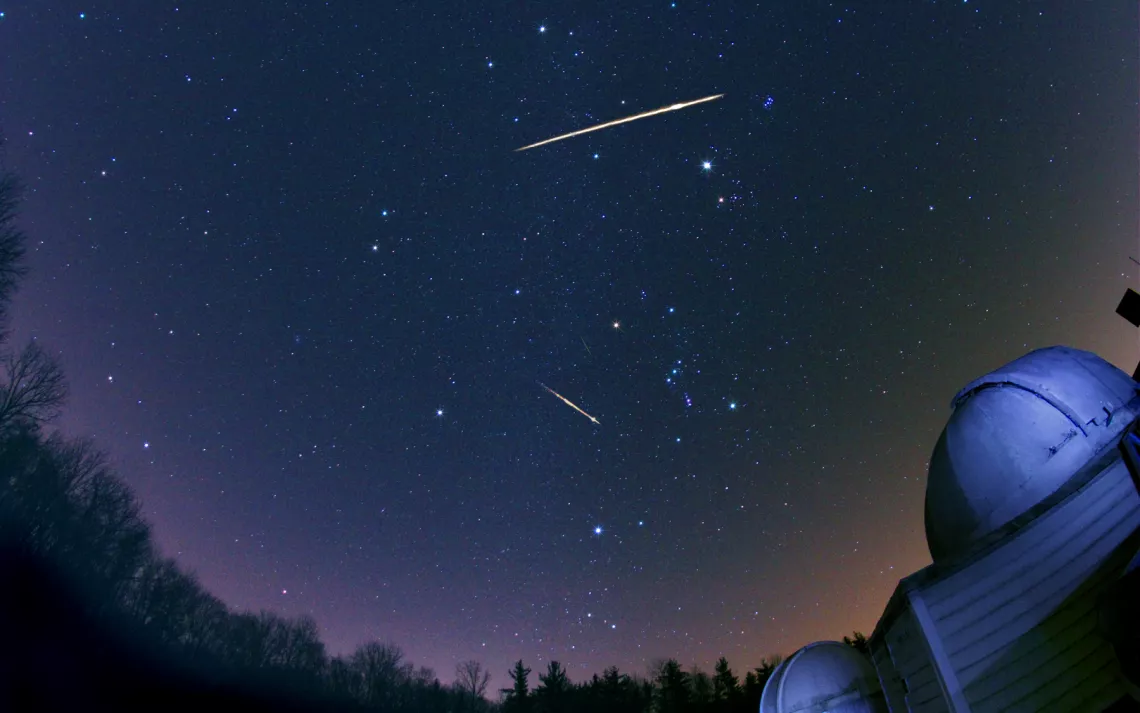December Astronomy Highlights: Castor and Pollux
There's lots to watch for during winter's cold, dark nights

The Geminid meteors in this image seem to point directly back to the stars Castor and Pollux in Gemini. | Photo by John Chumack
December may be chilly, but stargazing is almost unavoidable during its long nights. Whether we spot a planet during our evening commute or catch a shooting star on the way to our children’s school holiday concert, the dark skies and sparkling stars pull our attention upward. One of the better meteor showers of the year is the Geminids, whose activity peaks between December 13 and 14, with up to 120 meteors an hour possible.
The radiant, where the meteors appear to come from, is in Gemini—a fairly easy constellation to spot. Most people already know Orion, with its row of three bright stars, and Gemini the Twins is just to Orion’s upper left. The two main stars of Gemini, Pollux on the left and Castor on the right, are bright and easy to spot. The whitish blue Pollux is slightly brighter than Castor, whose shine is yellowish.
Castor and Pollux were mythological twin brothers, children of Leda—along with being names of characters in the third installment of the Hunger Games movies. Castor was the son of a mortal man, while Pollux was the son of Zeus. The astronomical Castor is not a twin to Pollux but is actually a sextuplet of its own; when you’re looking at Castor, you’re looking at not one star but six. Two of the six stars can be seen with help from a telescope. Each of those that we can see also has an unseen companion. And orbiting a bit farther out is another double star system, moving around the quadruple star system, which is what makes Castor a sextuple star.
Pollux is not a twin (or double star system), but it does have a companion: unseen planet orbiting it called Pollux b. This giant planet is about three times the size of Jupiter. At 34 light-years distant to Earth, Pollux b is one of the closest known extrasolar planets.
Continuing with our dark December theme, December’s full moon happens to be called the Long Night Moon. On December 6, the full moon will rise above the head of Orion. In December, the moon passes Uranus twice: on December 1 and December 28. In Anchorage, Alaska, on December 28 around 7:30 p.m., lucky observers can watch the moon occult Uranus and then watch as Uranus reappears from behind the other side of the moon a little less than an hour later.
Uranus is best spotted with a telescope, but brighter planets will be easy to locate this month. Venus is becoming obvious just after sunset in the southwest. On December 23 the crescent moon lies above Venus. Look for Mercury to Venus’s lower right. The two planets will have a close approach in January. Venus shall remain in the evening sky for eight months.
If tall buildings to your west obscure your view of the activity right after sunset, you can look for Mars and Jupiter. Mars enters Capricornus in December, and the crescent moon slides beside it on December 24. Once Mars sets in the west, look for Jupiter rising in Leo in the east-northeast on late December evenings. On December 11, the moon is close to Jupiter and the star Regulus, which trails behind Jupiter.
The solstice occurs on December 21 at 3:03 p.m. PST, bringing us winter. For much of the northern tier of the United States, the sun will not set after 5 p.m. again until sometime in January. Watch as that setting sun makes a slow creep from the south back toward the north.
 The Magazine of The Sierra Club
The Magazine of The Sierra Club







